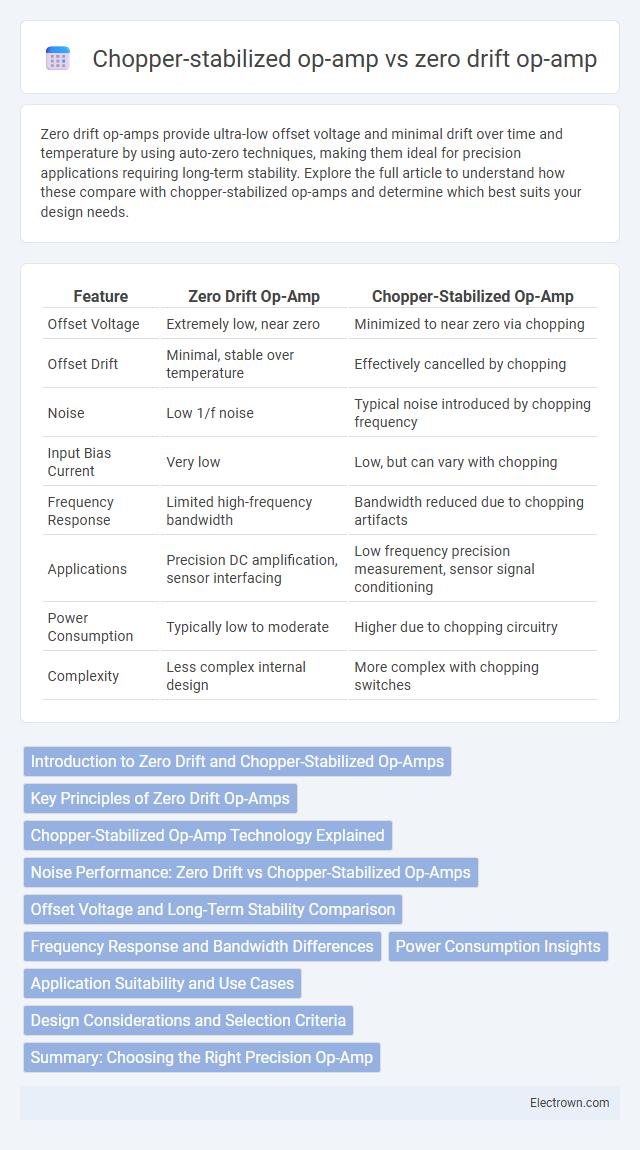Zero drift op-amps provide ultra-low offset voltage and minimal drift over time and temperature by using auto-zero techniques, making them ideal for precision applications requiring long-term stability. Explore the full article to understand how these compare with chopper-stabilized op-amps and determine which best suits your design needs.
Table of Comparison
| Feature | Zero Drift Op-Amp | Chopper-Stabilized Op-Amp |
|---|---|---|
| Offset Voltage | Extremely low, near zero | Minimized to near zero via chopping |
| Offset Drift | Minimal, stable over temperature | Effectively cancelled by chopping |
| Noise | Low 1/f noise | Typical noise introduced by chopping frequency |
| Input Bias Current | Very low | Low, but can vary with chopping |
| Frequency Response | Limited high-frequency bandwidth | Bandwidth reduced due to chopping artifacts |
| Applications | Precision DC amplification, sensor interfacing | Low frequency precision measurement, sensor signal conditioning |
| Power Consumption | Typically low to moderate | Higher due to chopping circuitry |
| Complexity | Less complex internal design | More complex with chopping switches |
Introduction to Zero Drift and Chopper-Stabilized Op-Amps
Zero drift op-amps, also known as auto-zero amplifiers, continuously correct their offset voltage to maintain ultra-low drift over time and temperature variations. Chopper-stabilized op-amps use a modulation technique that chops the input signal and demodulates the output, effectively minimizing offset and low-frequency noise for high precision in DC measurements. Your choice between these two depends on the required accuracy, noise performance, and application environment.
Key Principles of Zero Drift Op-Amps
Zero drift op-amps maintain ultra-low offset voltage by continuously correcting internal errors through auto-zeroing techniques and low-frequency chopping to minimize drift over temperature and time. Their architecture typically uses switched capacitor circuits or modulation-demodulation processes to achieve near-zero input offset voltage and near-zero input bias currents. This results in high precision, making zero drift amplifiers ideal for sensor interfaces and instrumentation applications requiring long-term stability and accuracy.
Chopper-Stabilized Op-Amp Technology Explained
Chopper-stabilized operational amplifiers utilize a modulation technique that periodically shifts the input signal to a higher frequency band, effectively minimizing low-frequency offset voltage and drift by synchronous demodulation. This architecture significantly improves precision and stability compared to traditional zero drift op-amps, which rely mainly on auto-zeroing circuitry to cancel offset voltages over time. The chopper method reduces 1/f noise and offset drift, making it ideal for ultra-low offset and low noise applications such as instrumentation and sensor signal conditioning.
Noise Performance: Zero Drift vs Chopper-Stabilized Op-Amps
Zero drift op-amps exhibit low-frequency noise reduction by continuously correcting offset voltage, resulting in minimal drift but still susceptible to residual flicker noise. Chopper-stabilized op-amps actively modulate and demodulate the input signal, virtually eliminating flicker noise and achieving superior noise performance in ultra-low frequency applications. For your precision measurements requiring the lowest possible noise floor, chopper-stabilized op-amps generally offer better noise characteristics than zero drift types.
Offset Voltage and Long-Term Stability Comparison
Zero drift op-amps exhibit extremely low offset voltage, typically in the microvolt range, due to continuous internal calibration, ensuring high precision in DC measurements. Chopper-stabilized op-amps employ a modulation technique to minimize offset voltage and offset drift, achieving similar low offset levels but with potential switching noise artifacts. Long-term stability in zero drift amplifiers is enhanced by low temperature and aging-induced offset variation, whereas chopper-stabilized amplifiers maintain offset stability over time but may experience degradation due to mechanical wear in the chopper switching components.
Frequency Response and Bandwidth Differences
Zero drift op-amps provide stable low-frequency operation with minimal offset voltage but typically exhibit limited bandwidth and slower frequency response due to their internal compensation mechanisms. Chopper-stabilized op-amps use a modulation technique to actively cancel offset, enabling a wider bandwidth and faster frequency response while maintaining low offset and drift. Your choice between these amplifiers should consider the required frequency range and precision, with chopper-stabilized op-amps being more suitable for high-frequency, low-offset applications.
Power Consumption Insights
Zero drift op-amps generally exhibit lower power consumption due to their simpler design and reliance on auto-zeroing techniques that minimize offset voltage without continuous correction. Chopper-stabilized op-amps often consume more power as they implement continuous chopping modulation to eliminate offset and low-frequency noise, requiring additional internal clocking circuitry. Power efficiency in zero drift designs makes them preferable for battery-powered and low-power applications where minimal energy use is critical.
Application Suitability and Use Cases
Zero drift op-amps are ideal for precision measurement applications requiring ultra-low offset voltage and long-term stability, such as industrial sensors, medical instrumentation, and data acquisition systems. Chopper-stabilized op-amps excel in low-frequency signal processing and noise-sensitive environments, making them suitable for audio equipment, seismic sensors, and strain gauge amplifiers. Both types offer exceptional offset accuracy, but zero drift op-amps provide better DC precision, whereas chopper-stabilized variants effectively minimize low-frequency noise and offset drift.
Design Considerations and Selection Criteria
Zero drift op-amps offer low offset voltage and minimal drift through auto-zeroing techniques, making them ideal for precision DC measurements requiring long-term stability. Chopper-stabilized op-amps utilize a modulation-demodulation process to effectively eliminate offset and 1/f noise, suited for ultra-low frequency applications needing high accuracy and low noise performance. Your choice depends on factors like required offset voltage, noise performance, power consumption, and application frequency, with zero drift op-amps favoring low noise and chopper amplifiers excelling in offset stability and low-frequency noise reduction.
Summary: Choosing the Right Precision Op-Amp
Zero drift op-amps offer ultra-low offset voltage and minimal drift over temperature, making them ideal for high-precision DC measurements. Chopper-stabilized op-amps use modulation techniques to eliminate offset and low-frequency noise, providing superior accuracy in low-frequency and slow signal environments. Your choice depends on whether you prioritize low noise and offset stability (zero drift) or enhanced performance in low-frequency applications (chopper-stabilized).
Zero drift op-amp vs chopper-stabilized op-amp Infographic

 electrown.com
electrown.com